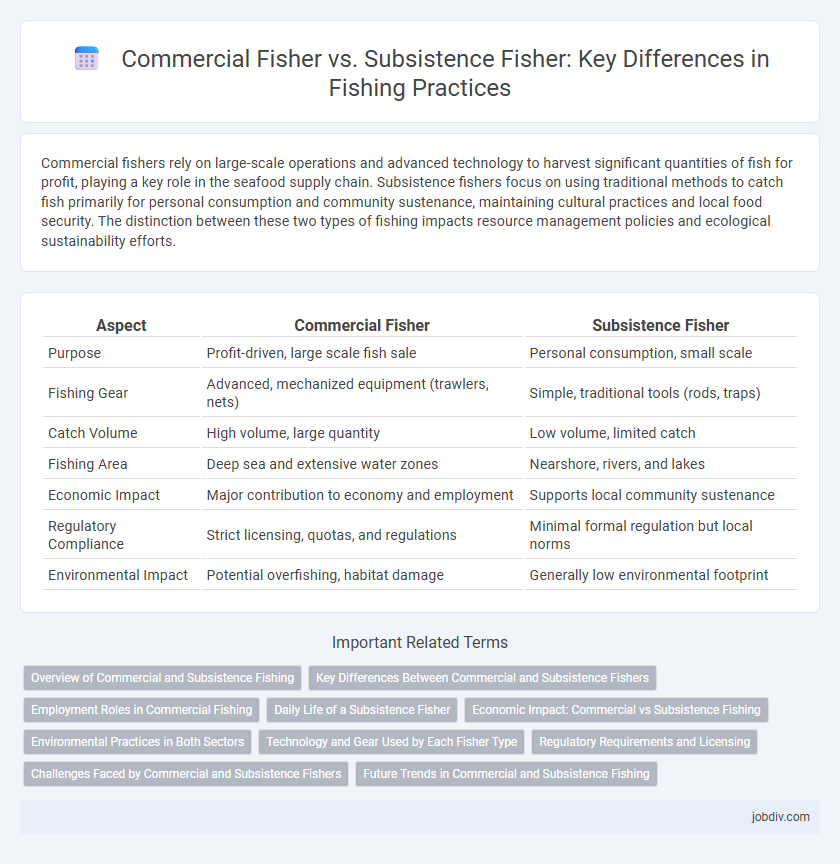Commercial fishers rely on large-scale operations and advanced technology to harvest significant quantities of fish for profit, playing a key role in the seafood supply chain. Subsistence fishers focus on using traditional methods to catch fish primarily for personal consumption and community sustenance, maintaining cultural practices and local food security. The distinction between these two types of fishing impacts resource management policies and ecological sustainability efforts.
Table of Comparison
| Aspect | Commercial Fisher | Subsistence Fisher |
|---|---|---|
| Purpose | Profit-driven, large scale fish sale | Personal consumption, small scale |
| Fishing Gear | Advanced, mechanized equipment (trawlers, nets) | Simple, traditional tools (rods, traps) |
| Catch Volume | High volume, large quantity | Low volume, limited catch |
| Fishing Area | Deep sea and extensive water zones | Nearshore, rivers, and lakes |
| Economic Impact | Major contribution to economy and employment | Supports local community sustenance |
| Regulatory Compliance | Strict licensing, quotas, and regulations | Minimal formal regulation but local norms |
| Environmental Impact | Potential overfishing, habitat damage | Generally low environmental footprint |
Overview of Commercial and Subsistence Fishing
Commercial fishing involves large-scale operations targeting high-volume catch for global markets, utilizing advanced technology and vessels to maximize efficiency and profit. Subsistence fishing is practiced primarily for local consumption and survival, relying on traditional methods with small-scale equipment that minimizes environmental impact. The socioeconomic roles differ significantly, with commercial fishing driving economic growth while subsistence fishing supports food security and cultural heritage in coastal communities.
Key Differences Between Commercial and Subsistence Fishers
Commercial fishers operate large-scale fishing vessels using advanced technology and equipment to supply global seafood markets, prioritizing high volume and profit. Subsistence fishers rely on traditional methods, fishing primarily for personal or community consumption, focusing on sustainability and local resource management. The economic impact, scale of operations, and environmental influence significantly differentiate commercial fishing from subsistence practices.
Employment Roles in Commercial Fishing
Employment roles in commercial fishing include deckhands, captains, engineers, and processors who operate large vessels using advanced equipment for mass harvest. These positions require specialized skills in navigation, machinery maintenance, and catch handling to meet market demands. Unlike subsistence fishers who fish primarily for personal or local community use, commercial fishers participate in a highly organized industry aimed at maximizing output and profitability.
Daily Life of a Subsistence Fisher
Subsistence fishers rely on traditional methods and small-scale gear to catch fish primarily for personal and community consumption, ensuring food security and cultural preservation. Their daily life involves long hours on local waters, often navigating unpredictable weather and seasonal fish patterns while balancing household responsibilities. Limited access to modern technology and markets drives a lifestyle deeply connected to nature and generational knowledge.
Economic Impact: Commercial vs Subsistence Fishing
Commercial fishing generates billions in revenue annually, driving significant economic growth through large-scale operations, export markets, and employment across industries. Subsistence fishing primarily supports local communities by providing essential food resources and preserving cultural traditions, with minimal direct impact on national economies. The economic impact of commercial fishing is substantial, yet subsistence fishing plays a crucial role in sustaining livelihoods and food security in rural areas.
Environmental Practices in Both Sectors
Commercial fishers implement advanced technologies and sustainable quota systems to minimize bycatch and protect marine ecosystems, often adhering to international regulations aimed at reducing environmental impact. Subsistence fishers rely on traditional methods that typically involve selective harvesting and lower catch volumes, which help preserve local biodiversity and maintain ecological balance. Both sectors contribute to environmental stewardship, but commercial fishing's scale necessitates stricter management to ensure long-term sustainability.
Technology and Gear Used by Each Fisher Type
Commercial fishers utilize advanced technology such as GPS, sonar fish finders, and large-scale trawling nets to maximize catch efficiency and operate on a large industrial scale. Subsistence fishers rely on traditional gear like handlines, traps, and small nets, often crafted from local materials, focusing on sustainable fishing to support their families. The disparity in technology reflects differences in fishing goals, scale, and environmental impact between commercial and subsistence fishers.
Regulatory Requirements and Licensing
Commercial fishers are subject to stringent regulatory requirements including mandatory licensing, quotas, gear restrictions, and reporting obligations to ensure sustainable harvests and ecosystem protection. Subsistence fishers typically face less formal regulation and may be exempt from licensing or allowed special permits, reflecting their use of fish primarily for personal or community consumption rather than profit. Regulatory frameworks vary by region but generally prioritize conservation while accommodating the cultural and livelihood needs of subsistence fishers.
Challenges Faced by Commercial and Subsistence Fishers
Commercial fishers face challenges such as overfishing regulations, high operational costs, and fluctuating market prices that impact profitability. Subsistence fishers struggle with limited access to resources, climate change effects reducing fish stocks, and inadequate infrastructure for storing and transporting their catch. Both groups encounter increased competition and environmental pressures threatening their livelihoods and food security.
Future Trends in Commercial and Subsistence Fishing
Future trends in commercial fishing emphasize sustainable practices driven by advanced technology, such as satellite monitoring and AI-based stock assessments, to prevent overfishing and support marine ecosystems. Subsistence fishers are increasingly integrating traditional ecological knowledge with modern conservation methods to enhance food security amid climate change impacts. Both sectors show a shift towards responsible resource management, with policies promoting ecosystem-based approaches and community involvement for long-term fishery resilience.
Commercial Fisher vs Subsistence Fisher Infographic

 jobdiv.com
jobdiv.com